
Split
Designed to free the brain and stay focused
Split designed to free the brain and stay focused. It detects the user's brain activity to more accurately understand your level of concentration. And use gamification to present the results.
Time
2022
Project Type
UX/UI Design
Skills&tools
Figma,
Adobe PS, AI, XD
A/B Test
Millennials Are Always Exhausted
Technology takeover: Impacting your brain and body
Hustle culture: A mindset and, often, a financial reality
Poor coping behaviors: A complication of stress
——Healthline, Meagan Drillinger
Our brains are constantly multitasking
This leaves us exhausted and tired very quickly. Focus can make us more energetic and even more creative.
Dr. Daniel Levitin: Every time you shift your attention from one thing to another, the brain has to engage a neurochemical switch that uses up nutrients in the brain to accomplish that. So if you're attempting to multitask, you know, doing four or five things at once, you're not actually doing four or five things at once, because the brain doesn't work that way. Instead, you're rapidly shifting from one thing to the next, depleting neural resources as you go.
———TED speech 'How boredom can lead your most brilliant ideas'
How design helps people stay focused?

Split gamification design
Compared to pure meditation or concentration apps. Split adds hardware support and uses gamification to help users intuitively understand their level of focus. Through the brain wave detection device, the user can accurately obtain the concentration information. Instead of relaxing or meditating with white noise or simple pictures.

Brainwave detector
Mobile app
support the game data
user
provide game interface
control the device
Mobile app
A start point for users to set up the device. Record users meditation data. Provide split game interface.
Brainwave detector
A lightweight brainwave detection device. By wearing this device, users can control the balloons in the split game.
Split game
A little game to visualize the concentration level of users. The slower the balloon splits, the more focused the user is.
Split game
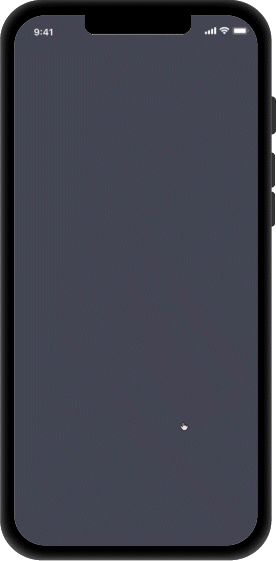
weclome page

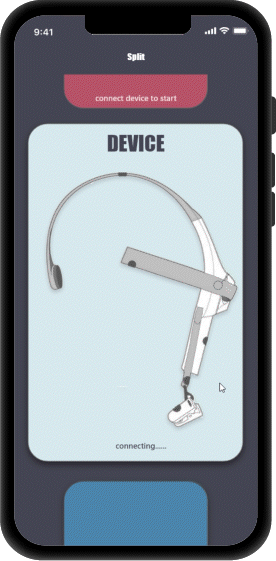
connect device to start
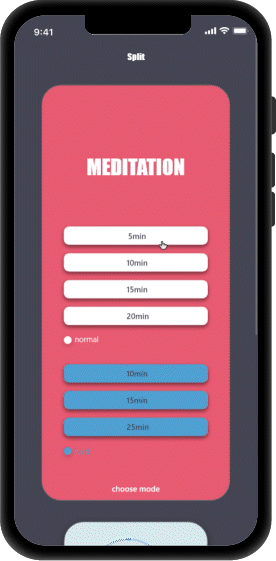
choose meditation time
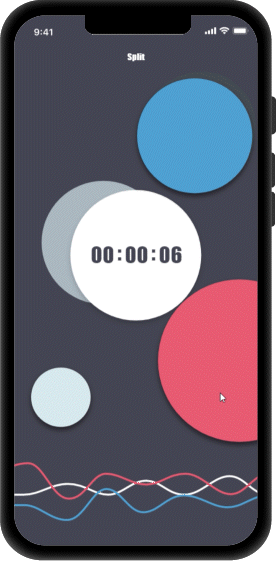
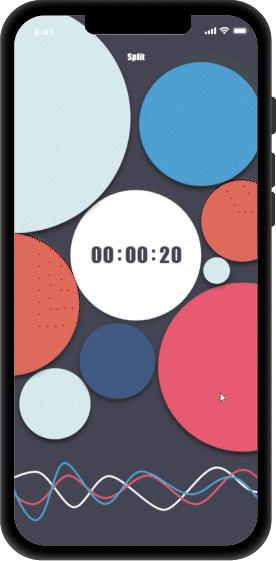
try to stay focus

score board
Design process

Research
Understand/investigate the problem, identify the need

Ideate
Generate ideas
weigh main elements

Design
Develop interface
ensure technical path

Test
Prototype test with users and gain feedbacks
Investigation - Typical modern life

Nowadays, people’s working hours have increased slightly over the past.
People spend more time on mobile devices, and the brain needs to process more information than before.
People shift their attention more frequently between tasks.
Research - How does brain handle multi-tasking? (the reason easy to get tired)

eat
talk
refresh twitter
Many people believe that the brain can accomplish multiple tasks at the same time.

eat
However, we overestimate the brain's ability. Our brain can only focus on one task at a time.
Because the brain ‘cheats’, we mistakenly think that we are doing multiple tasks at the same time.

Scene: reply to the message while eating
The brain cannot use different areas to accomplish different tasks.
In a short time, the brain switches multiple times between two tasks.
Every time we swithch our attention from one thing to another, the brain has to engage a neurochemical switch that uses up nutrients in the brain to accomplish that. So if we are attempting to multitask, doing four or five things at once, we are not actually doing four or five things at once, because the brain doesn't work that way. Instead, we are rapidly shifting from one thing to the next, depleting neural resources as we go.

Shifting one thing to the next cost extra energy
Business opportunities
The number of searches for yoga and meditation apps increased by 65%
1. Stress and Mental Healthcare Awareness
In the present day, around 75% to 90% of people in the United States visit doctors for stress-related issues and around 13% of kids show symptoms of anxiety disorder because of stress.
Because of this, more and more people are becoming conscious of the ill effects of stress and turning to meditation to improve their mental health. Something that is giving a push to the mindfulness app development market.
2. Rise in Use of Smartwatches and Smart Screens
With an increase in the number of smartwatches and smart screens, people are getting an opportunity to keep a real-time record of their mental health and well-being. So, whenever they are feeling low or stressed, they turn to meditation apps like Calm that guide them into a state of mindfulness. This is again favoring the flourishing market for meditation apps.
Now while you know the reasons that ignite the zeal to develop mindfulness apps like Calm or HeadSpace, let’s move to the best mindfulness meditation apps in the market.

The US meditation market is anticipated to be valued at $2.08 billion by the year 2022.
Meditation, yoga, and good sleep have become an inevitable part of everyone’s lives to ensure good health, considering the amount of stress we deal with at the workplace and in our personal lives every day. The outbreak of the pandemic has undoubtedly added to the stress we live under.
All this considered, it’s no surprise that the demand for meditation and mindfulness apps is growing every year. These apps make it easy for users to get into that meditative zone and relax their brains. A few meditation apps also add the element of gamification to attract users and divert them from self-destructive thoughts.
This increasing popularity of meditation apps is also attracting more and more businesses to enter the industry and earn a good sum of money.

Revenue in the meditation apps segment is projected to reach US $6,717.18m by 2026

Monthly willingness to pay based on average meditation duration

Monthly willingness to pay based on average meditation goal
Meditation App analysis

Calm is an award-winning mindfulness app, has over 100 million downloads and more than 700,000 5-star reviews.
-hundreds of calming exercises
-helpful breathing techniques
-leep stories narrated by celebrities
Calm has many offerings and the interface is relatively simple to navigate through. Plus, they’re constantly adding new content.
Calm’s user interface is cluttered and confusing overall. The sessions within each of the 10 sections aren’t alphabetized, and it’s not always obvious what some refer to.

Meditation sessions can primarily be found in Packs, Singles, and Minis, which cover a wide array of topics and can range from 1 to 60 minutes in length.
-the style of the headspace is very fresh.
-headspace adds helpful interruptions at the beginning of meditation sessions, logins, notifications, and more.
-Headspace can start proactively recommending the kinds of meditation for me to do based on any given time, location, and historical meditation sessions.

Meditopia users talk more about meditations than sleep stories. they use meditations more than sleep stories for sleep improvement, even if there is a story section.
-Improve the quality of sleep by adding exclusive content to your program. Fall soundly asleep in 5 minutes.
-Daily 1-to-1 guidance to improve emotional health and reduce stress and anxiety.
-Users who talk about the diversity of content have positive feelings about the app.

Healthy Minds Program is a free, no-frills app that centers on four key ideas: Awareness, Connection, Insight, and Purpose.
-Upon first use, this app prompts you to take a survey that gives you a score for each of the four pillars—a baseline from which you can improve over time.
-Provide a simple, straightforward path to meditation without ads or constant pop-ups.
-a simple, straightforward path to meditation without ads or constant pop-ups.
Gamification to engage more users
Gamification can lead to user growth. For example, setting goals and offering reachable rewards. A notable example is fitness and exercise apps that have made good gains when combined with AR/VR games. I believe that using gamification can also increase user viscosity.
Think less to gain more
App

Mind sensor

mindlink device (available on the market)
brainwave visualization
Meditation Game

no fluctuation
low fluctuation
high fluctuation
The number of balls covers the entire screen before the end of the countdown.
one ball at first
begins to split
the ball splits faster and the number increase
limited balls on the screen.
User flow

Split mobile app


